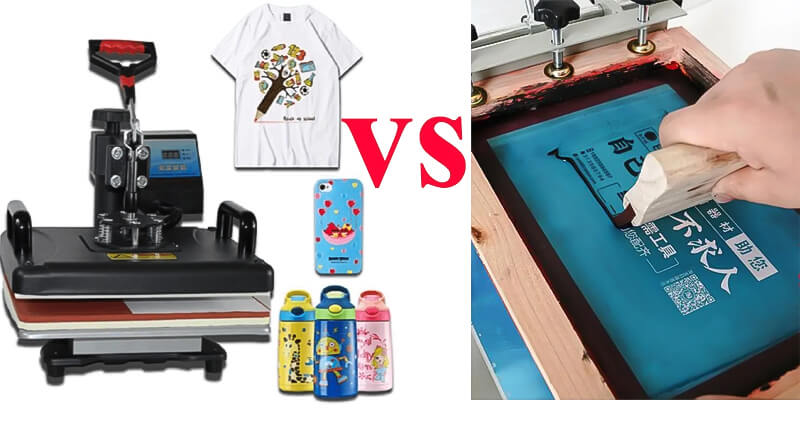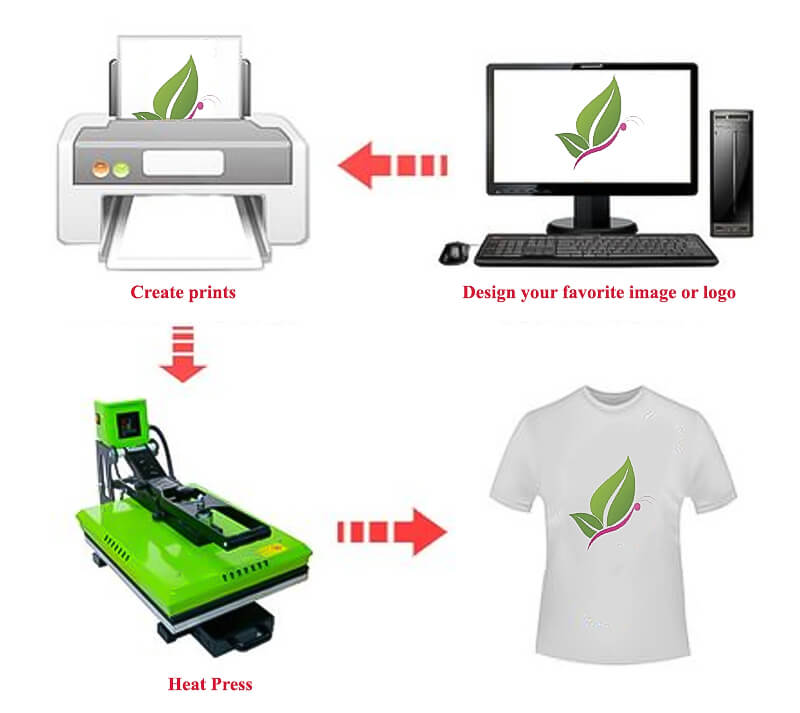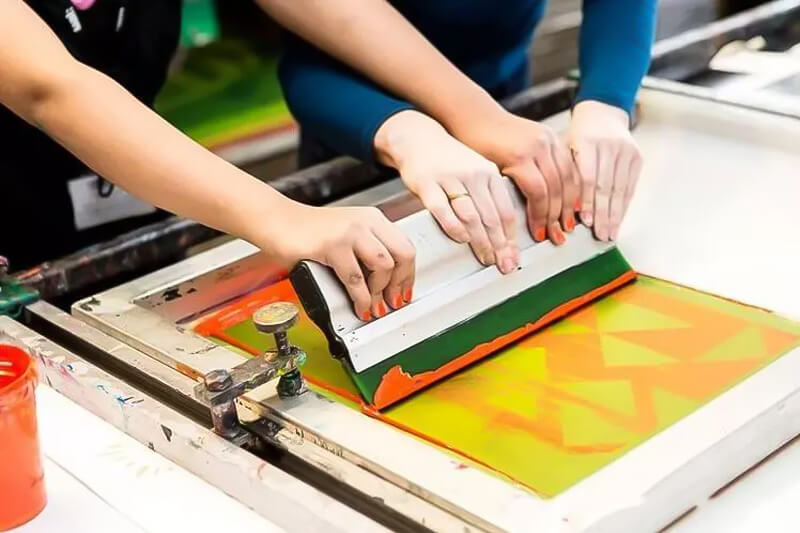Screen Printing Vs Heat Press: Unraveling the Best Method
Looking to elevate your T-shirts with unique designs? Choosing between screen printing and heat transfers might seem daunting. But don’t worry, you’re in good company! Both methods are top picks for apparel decoration, offering distinct benefits and downsides. Our comprehensive analysis sheds light on crucial contrasts in price, design intricacy, print clarity, and durability. Explore this guide to determine when heat transfers trump screen printing. By the conclusion, you’ll confidently pick the perfect technique for your one-of-a-kind T-shirt designs. Let’s journey through the T-shirt printing universe together!
Is it better to screen print or heat press?
Selecting between screen printing and heat transfer for your shirts largely depends on your specific requirements and financial plan.
For bulk orders showcasing a consistent design, especially with limited colors, screen printing emerges as the best choice. It’s not only budget-friendly for large volumes, but its distinct ink assures a durable finish.
Conversely, if you’re targeting small quantities with personalized designs or vibrant multi-color motifs, heat transfer printing (HTP) is the way to go. HTP offers a swift, cost-efficient method of embedding rich designs onto shirts in mere minutes. If you’re concerned about time and wondering, How Long Does It Take To Print A Shirt, this method can be a quick solution. If you are exploring alternatives to these methods, you may also want to learn about What Is A Screen Print Transfer, another popular printing technique.
For sharp, high-definition images, like photo-like prints, heat transfers typically surpass screen methods. However, for basic designs or straightforward text logos, both techniques are commendable. But remember, screen printing might have a slight advantage in lasting appeal due to its unique ink.
In essence, while heat transfer shines in delivering detailed designs with precision, screen printing is the go-to for extensive orders, ensuring an extended lifespan. Consider your project’s distinct needs and your available funds when deciding on the optimal printing approach.

What is Heat Transfer Printing?
Heat transfer printing is a widely favored technique in garment embellishment, utilizing heat-pressed graphics to craft personalized attire for businesses, sports teams, and individual enthusiasts.
Heat transfer printing process and techniques
Heat transfer printing, often termed thermal transfer printing, involves using heat and pressure to embed pre-designed images or patterns onto various materials. This technique is especially popular for adorning fabrics, ceramics, and an array of other items.

Heat Transfer Printing Process:
1. Design Creation: Start by choosing or crafting a high-quality design. Ensure it’s tailored to the specific material you’ll be printing on.
2. Design Printing: Your chosen design gets printed onto specialized heat transfer paper. Remember, the ink type varies depending on the method you select.
3. Heat Application: With the design now on the transfer paper, position it onto your chosen material. Utilizing a heat press machine, apply both heat and pressure to transfer the design smoothly. If you’re wondering what size heat press is best for shirts, our comprehensive guide can help you make an informed decision. For a comprehensive understanding of how to actually make these transfers for T-shirts, check out our guide on How To Make Transfers For T-Shirts.
4. Final Touches: After heating, let the material cool down. Next, peel off the transfer paper gently to unveil the transferred design. For a comprehensive understanding of how heat presses operate, you can read our guide on What Is A Heat Press.
Key Techniques:
- Sublimation: Ideal for polyester materials. Under heat, the ink transitions from solid to gas, merging the design into the fabric.
- Vinyl Heat Transfer: Here, designs are meticulously cut from colored vinyl sheets before being pressed onto the material. Perfect for designs with a few colors. But which t-shirts are the best for this method? Find out in our guide on What Is The Best T-shirts For Heat Press.
- Plastisol Transfers: Think of it as screen printing but on transfer paper. Once printed, it’s heat-transferred to the material, giving an effect similar to direct screen printing.
- Digital Transfers: These leverage print-and-cut digital printers. The result? Multi-colored designs are neatly transferred onto your chosen medium.
- Inkjet & Laser Transfers: Great for DIY projects or smaller tasks. They use standard printers but with specialized transfer papers.
- Direct-to-Garment (DTG): A technique where the design is printed directly onto fabric using inkjet printers.
For the best outcome, ensure uniform temperature and pressure in the heat press. And don’t forget, always conduct a preliminary test before your main printing spree.
Quickly compare the pros and cons of Heat Press and Screen Printing
| Heat Transfer Printing | Screen Printing | |
|---|---|---|
| Pros | – Higher-resolution designs generally look better when new
– Cost-effective for smaller orders – Flexibility in the complexity of designs – Relatively easy process with a special printer, quality paper, and a heating press |
– Designs are durable and soak into fabrics, making them less susceptible to fading or cracking over time
– More cost-efficient for larger quantities – Offers a traditional, professional finish |
| Cons | – Quality may deteriorate over time with washing and wear
– More expensive for larger, bulk orders due to the process and materials required |
– Not as suitable for complex multicolor or photographic designs
– The set-up process is lengthy and costly, making it less suitable for small orders |
In a nutshell, heat transfer printing excels for smaller batches with intricate or detailed designs, whereas screen printing shines for bigger quantities and boasts greater durability. Your final decision between the two should consider aspects like design detail, volume of order, and financial constraints.
Durability and Longevity
Deciding between heat press and screen printing requires assessing the longevity and durability of each method. If you’re wondering about other methods, you might want to consider What Is Embroidery Printing.
With the prints either embedded within the fabric fibers or situated on the surface, they resist extensive wear, ensuring minimal fading. This means the vibrant appearance remains intact for a longer duration, unlike certain other ink types. If you’re intrigued by these techniques and want to create your own, discover How Do I Make My Own Screen Print Transfers.
Conversely, screen printing is renowned for its unmatched quality. With the ink deeply infused into the fabric, it yields vivid, long-lasting images.
Additionally, screen-printed items possess enhanced washability. The printing process results in more breathable fabric, allowing for thorough washing. This makes screen-printed garments especially suitable for items that undergo frequent wash cycles over an extended duration.
Which lasts longer screen printing or heat transfer?
Screen printing:
- Typically lasts longer with proper care.
- Thicker ink feels on the fabric.
- Multi-colored designs can be more complex.
Heat Transfer:
- Durability varies; vinyl transfers can be durable, while digital prints might fade faster. If you’re asking yourself, Does Heat Transfer Vinyl Last, you’ll find that vinyl transfers, when applied correctly, can offer lasting results.
- Vinyl has a distinct feel, while digital prints are softer.
- Easily handles multiple colors and gradients without extra costs.
If you’re looking for a specialized service to personalize your t-shirts with intricate designs or logos, custom heat transfer might be the ideal solution for you.
When considering the question Does Screen Printing Last,a well-done screen print might outlast some heat transfers, but vinyl heat transfers, when applied correctly, can be comparably durable. For a more in-depth comparison, check out our guide on Embroidery vs Heat Press.
What is Screen Printing?
Screen printing is a fabric decoration technique wherein ink is transferred to apparel or other fabrics with the help of a mesh screen and squeegee. This method is especially popular for t-shirts but Can You Screen Print On Polo Shirts? The answer is yes.

Process and technique
Screen printing is a method that uses a mesh stencil, known as a screen, to transfer ink onto a material. Here’s a step-by-step breakdown:
- Design Creation: Start by designing your graphic. Once ready, print it onto a transparent acetate film.
- Screen Preparation: Choose a screen with the right mesh count and coat it with a light-sensitive photo emulsion.
- UV Exposure: Position the acetate film on the screen and expose it to UV light. The emulsion hardens where light hits, but areas under the design stay soft.
- Developing the Stencil: After UV exposure, wash the screen. The soft emulsion areas wash away, leaving a stencil of your design.
- Ink Application: Place the screen over your material. Pour ink onto the screen and use a squeegee to push ink through the stencil, transferring the design onto your material.
- Layering for Multiple Colors: For designs with multiple colors, each color requires its own screen. Dry each layer of ink before applying the next.
- Setting the Design: Once the printing is done, use heat to set the ink, ensuring it’s durable and long-lasting.
Screen printing is prized for its ability to produce vibrant, lasting colors, especially on fabrics, making it a popular choice for T-shirt designs and other apparel.
Can you use a heat press for screen printing?
Yes, a heat press can be used in conjunction with screen printing, but not for the actual act of printing. Here’s how a heat press might be integrated into the screen printing process:
- Curing Ink: After screen printing, the ink requires curing to ensure durability. A heat press can achieve this, especially for smaller batches.
- Heat Transfers: Designs can be first screen printed onto transfer paper. These can then be applied to garments using a heat press, offering flexibility in production.
- Adding Special Effects: After the primary screen printing, elements like heat transfer vinyl can be incorporated with a heat press for mixed-media designs.
- Setting Specialty Inks: Certain inks or effects, such as foil, may require a heat press for proper adherence.
When using a heat press in the screen printing process, it’s essential to follow best practices to ensure the ink is cured properly and the garment isn’t damaged. This includes testing different heat settings and press durations for various inks and materials. Always consult the ink manufacturer’s recommendations and do tests before producing a large batch.
Durability
Screen printing is often championed for its superior durability. When we pit screen-printed products against those from a heat press, the former typically emerges more resilient. This is attributed to the fact that in screen printing, the ink penetrates deeply into the fabric. This immersion results in products that stand up to wear and tear, boasting impressive resistance to fading or peeling. In contrast, while vinyl transfers from heat presses might endure, they can discolor over repeated use.
The longevity offered by screen printing is notably higher than what you’d get with heat transfer printing.
Moreover, screen printing is lauded for its vibrant color reproduction. Such vivacity is a feat hard to achieve with heated vinyl transfers. For instance, if a company wants its logo prominently displayed on promotional jackets, they might gravitate towards screen printing. The reason? The unmatched vibrancy that screen printing lends to designs, is something unattainable with heat presses.
Lastly, it’s worth noting that neither printing method is notably affected by regular washing. Both remain steadfast, promising longevity, making them worthwhile investments for branding or aesthetic appeal.
Differences Between Heat Transfer and Screen Printing
Get a comprehensive look at the differences and advantages of heat transfer printing compared to screen printing for your garment decoration needs.
Cost and Expense Analysis
When comparing the costs of heat transfer and screen printing, it’s vital to consider various factors. At first glance, screen printing might seem pricier for small apparel orders. However, larger batches, often become the more economical choice, thanks to available bulk pricing. If you are also considering embroidery as an option, you may find our Embroidery vs Screen Printing guide useful for a comprehensive cost comparison.
Conversely, heat transfers often shine for smaller batches, say around 12 or 24 pieces. This could make them pricier in specific situations. Equally crucial is the project’s overall quality. Factors like durability, resolution, and design intricacy hold significant weight.
Given these nuances, one method might prove more cost-effective than the other. Hence, thorough research becomes essential to identify the method that aligns best with your goals.
Is screen printing more expensive than heat press?
Screen Printing:
Pros:
- Economical for Large Orders: While there are initial setup costs, screen printing becomes more cost-effective per item as the order quantity increases.
- Durability: Offers long-lasting prints, especially when done and cured correctly.
Cons:
- Setup Costs: Requires a separate screen for each color, increasing the initial costs for multi-color designs.
- Complexity with Multi-color Designs: Detailed designs with numerous colors can be challenging and more expensive to set up.
Heat Press:
Pros:
- Versatility: Great for small orders, custom jobs, or designs with multiple colors and gradients.
- Lower Initial Costs: Especially beneficial when dealing with small quantities or varied designs.
Cons:
- Durability Variance: Depending on the method (vinyl, digital transfer, etc.), the print might not be as durable as screen prints.
- Cost per Item: For smaller quantities, the cost per item might be higher compared to bulk screen printing.
Overall: For intricate, multi-color designs or small quantities, heat pressing might be more economical. However, for bulk orders with fewer colors, screen printing often offers better value for money and durability.
Complexity of designs
The complexity of designs plays a significant role in choosing the right method of printing or production, as well as in determining the cost and time required.
1. Screen Printing:
- Multi-color designs require separate screens for each color, which increases setup time and cost.
- Gradients and intricate details can be challenging to reproduce.
- Color registration (alignment of different colors) becomes crucial and can be tricky for very detailed designs.
2. Heat Press (Heat Transfer):
- Ideal for complex designs, especially when using digital transfers.
- Gradients, photographs, and detailed graphics can be reproduced well.
- Vinyl transfers, however, are better suited for simpler designs since each color or detail would need to be cut and weeded separately.
Quantity and bulk discounts
When choosing between screen printing and heat press for custom-printed items like t-shirts, the quantity ordered and potential bulk discounts significantly influence the decision.
Screen printing often comes with steeper discounts than heat transfer prints. This means that customers ordering in bulk can enjoy reduced per-unit costs.
Take, for instance, an order of 100 pieces or more. Such orders can unlock discount rates, a perk that might not always be available with heat press prints. While the initial costs for screen printing might exceed those of heat press transfers due to the intricate setup for certain designs, the per-item cost can drop substantially when ordered in larger volumes.
Quality of results
When deciding on a printing method, the quality of the final product is a pivotal consideration. Heat transfers stand out for their superior resolution and intricate detailing compared to screen prints.
Heat transfer designs excel in print clarity, image quality, and precision of details. These prints burst with bright, vivid colors when fresh and retain their vibrancy without compromising on durability. There’s no fear of the design fading or cracking as time goes on.
Conversely, screen printing integrates more deeply into the fabric. This results in a subtler but enduring print, capable of withstanding numerous washes without any decline in quality, in contrast to heat transfers.

Which Method is Best for Your Needs?
Choosing between heat press and screen printing largely depends on the specifics of your project. Here’s a guide to help you determine which is best for your needs:
1. Design Complexity:
- Simple Designs with Few Colors: Screen printing is effective and can result in a clean, vibrant finish.
- Detailed, Multi-colored Designs: Heat press, especially digital transfers, can reproduce intricate designs and gradients with more accuracy.
2. Quantity:
- Large Orders: Screen printing often becomes more cost-effective with larger quantities due to the lower per-item cost after the initial setup.
- Small Orders or Individual Pieces: Heat press is usually more economical for smaller quantities because it doesn’t have the high initial setup costs associated with screen printing.
3. Turnaround Time:
- Quick Turnaround: Heat pressing can be faster for small batches since it doesn’t require the setup time that screen printing does.
- Bulk Orders: Once set up, screen printing can quickly handle large quantities.
4. Material & Fabric Type:
- Natural Fibers (e.g., Cotton): Both methods work well, but screen printing is especially popular.
- Synthetic Fibers (e.g., Polyester): A heat press, particularly dye sublimation, is suitable. Some screen printing inks might not adhere well to synthetics.
5. Durability:
- Long-lasting Print: Screen printing typically offers a more durable design that can withstand numerous washes without fading.
- Short-term Use: Heat press designs, especially some digital transfers, might fade faster over time, although high-quality transfers can also be quite durable.
6. Budget:
- Cost-effective for Large Runs: Screen printing often becomes cheaper per unit with bulk orders.
- Cost-effective for Small Runs: Heat press generally has lower upfront costs for smaller orders.
7. Feel & Appearance:
- Smooth, Integrated Print: Screen printing inks permeate the fabric, resulting in a design that’s more integrated into the material.
- Layered Feel: Heat press, especially vinyl transfers, may feel like an additional layer on the fabric.
Conclusion
To sum it up, choosing between heat press and screen printing boils down to your design’s complexity, order size, and budget constraints. For intricate designs that need swift turnaround and affordability, heat transfers might be your go-to. However, for bulk orders with intricate designs, screen printing could be both a cost-effective and durable alternative.
Yet, it’s wise to explore all options, including direct-to-garment (DTG), sublimation, or vinyl prints, before settling. The ideal method aligns with your unique requirements. So, invest some time evaluating each option against your specific needs.
FAQs
1. Which method is best for t-shirt printing?
The best method depends on the specific needs of the project. Screen printing is ideal for large orders with fewer colors as it provides vibrant color outputs and is cost-effective in bulk. Digital printing (like Direct-to-Garment) is better for designs with a lot of details or color gradients and is more suitable for smaller orders.
2. Is screen printing better quality than digital printing?
“Better” can be subjective. Screen printing provides vibrant colors, especially on darker fabrics, and can last for many washes. It’s also better for bulk orders. Digital printing offers more detailed designs and is ideal for full-color photos or designs with gradients. Its quality is impressive but may fade faster than screen prints after several washes.
3. What is the difference between heat press and sublimation shirts?
Heat press typically involves pressing a design onto a shirt using heat and pressure. The design is usually on a special transfer paper or vinyl. Sublimation, on the other hand, is a process where special ink becomes a gas when heated and then bonds directly with the fibers of the shirt, resulting in a design that feels more like part of the fabric.
4. How long does screen printing last on t-shirts?
With proper care, screen-printed designs can last for years. It’s not uncommon for a screen-printed shirt to maintain its design quality for 50 washes or more. The longevity can vary based on the quality of the ink used, the fabric of the shirt, and how the shirt is cared for (e.g., wash settings, use of bleach, drying methods).





